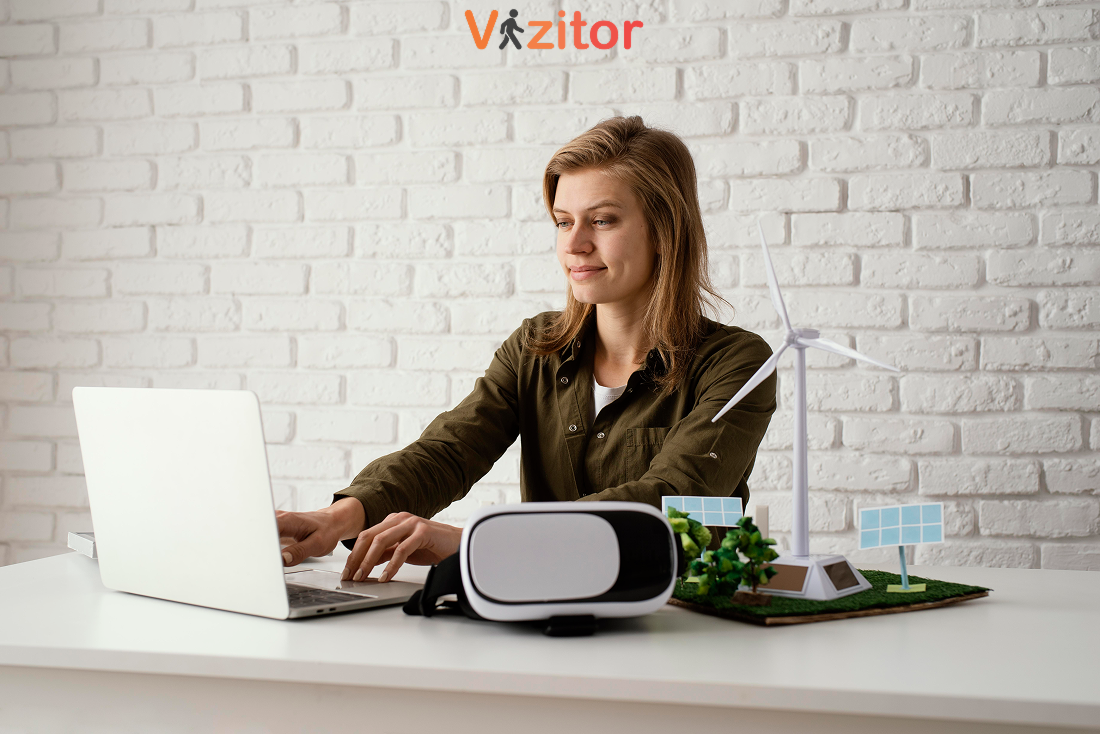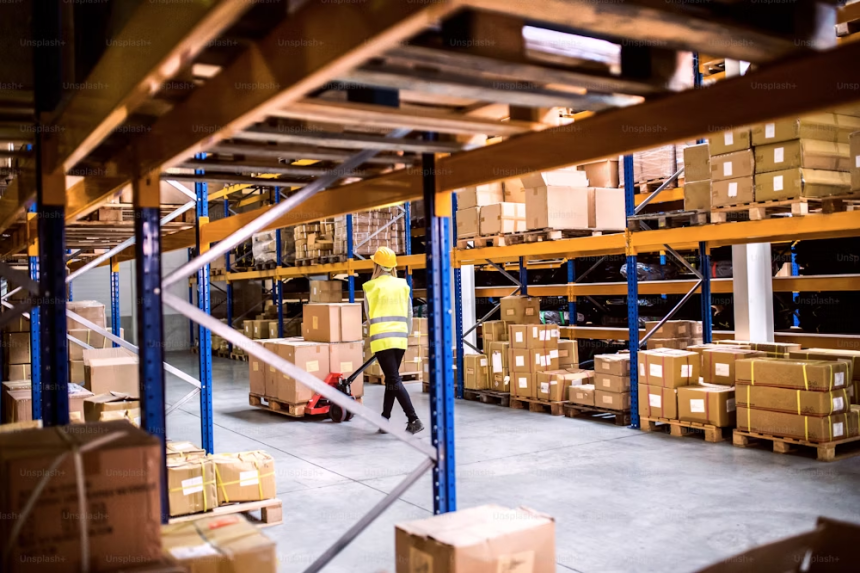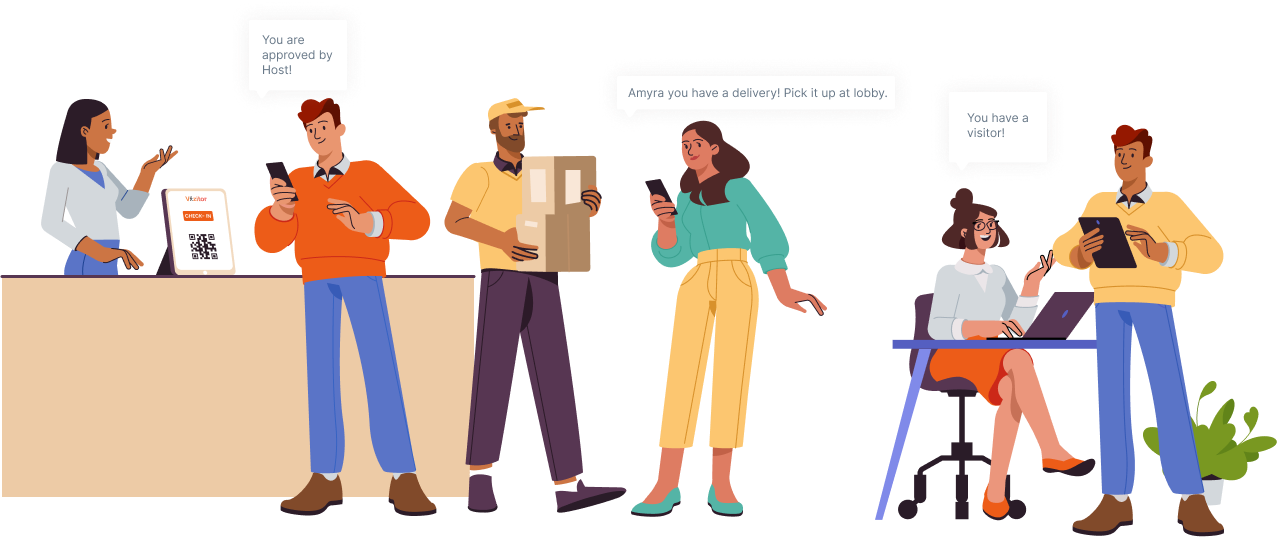Table of Content
Try Vizitor for Free!

Wed, Feb 26, 2025
Read in 9 minutes
Your office isn’t just a place—it should be a hub of productivity. But too often, it turns into a mess of empty desks, overbooked meeting rooms, and confused visitors, wasting both time and money. With hybrid work on the rise and office costs increasing in 2025, poor space management isn’t just frustrating—it’s a big problem.
But here’s the good news? Smart Technology can fix it. Efficient office space utilization is crucial for businesses looking to enhance productivity, reduce costs, and improve employee satisfaction.
From smart Check-ins to real- time tracking analytics, businesses can use smart solutions and tools to make data-driven decisions.
At Vizitor, our space management solution helps you cut waste, improve the work environment, and make your office more efficient.
This article explores five innovative ways technology is transforming office space management in 2025, helping businesses maximize efficiency and improve their work environments.
Get ready to discover five powerful ways technology can transform your office space.
1. Smart Desk Booking for a Clutter-Free Workspace
Let’s suppose a scenario when you walk into the office, coffee in hand, ready to crush it—only to find someone’s already claimed your favorite desk.
Doesn’t that sound like a common situation?
One of the biggest challenges in office management is tracking space utilization.
Implement smart desk booking systems, a cornerstone of modern space management technology.
With Vizitor’s space management solution, employees can reserve desks in advance via an app—no more awkward “Is this taken?” moments. The system tracks usage in real time, ensuring no seat goes to waste.
Imagine a hybrid team of 50 people: instead of overbooking a 100-desk office, data-driven insights could shrink that to 70 desks, saving on rent and utilities.
How does smart desk booking improve office efficiency? It slashes wasted time, boosts focus, and keeps the day flowing. Think of it as your office’s personal bouncer, keeping the riffraff of disorganization out.
How can your workplace be benefited:
Eliminates wasted space: Companies can downsize or repurpose areas based on actual usage.
Improves employee experience: Ensures availability of meeting rooms and workspaces when needed.
Reduces operational costs: Lowers energy consumption by automating lighting and HVAC systems.
A 2025 JLL survey found 78% of workers want control over their workspace, and this delivers. It’s not just about desks; it’s about empowerment. When your team feels in charge, they’re happier—and happier people get stuff done.
2. Visitor Management System for Smart Space Optimization
In modern workplaces, managing visitors efficiently is no longer just about tracking who comes and goes. It’s also about optimizing office space to ensure smooth operations and maximum efficiency.
A visitor management system (VMS) that also helps with space planning is like having a two-in-one tool for your office. Instead of just tracking guests, the system helps manage office space efficiently.
Here’s how a Visitor Management System like Vizitor can play a crucial role in office space planning:
- Real-Time Occupancy Tracking
A visitor management system records visitor and employee check-ins in real time, offering a clear picture of office occupancy.
By analyzing this data, facility managers can determine which areas are frequently used and which remain underutilized. Vizitor provides detailed reports and analytics on visitor flow, helping businesses optimize space usage efficiently.
- Capacity Control & Compliance
Overcrowding can reduce productivity and violate safety regulations. A visitor management system helps maintain compliance by tracking the number of people inside the office at any time. Vizitor enables businesses to set capacity limits and receive alerts when occupancy exceeds safe levels.
- Optimized Office Layouts Using Data Insights
Space planning requires data-driven decisions. Vizitor collects valuable visitor movement data, helping businesses identify high-traffic areas and adjust layouts accordingly.
For example, if reception areas are often crowded, seating arrangements or check-in processes can be modified to improve flow.
As hybrid work models and flexible office spaces continue to rise, companies need smarter space management solutions.
With Vizitor’s Visitor Management System, organizations can ensure optimized space utilization, reduced costs, and a seamless workplace experience for both employees and visitors.
3. Using Mobile Apps to Optimize Space at Your Fingertips
Your smartphone already helps you manage your day—from emails to meetings to ordering lunch. So why not use it to manage your office space too? Mobile apps are transforming office space management, giving employees and facility managers the power to optimize workspaces, track occupancy, and ensure smooth operations—all with a simple tap.
A mobile-first approach allows businesses to stay agile and responsive to changing workspace needs. Here’s how:
1. Easy Desk and Meeting Room Booking
Instead of searching for an available desk or conference room, employees can reserve their spot in advance through an app. This not only reduces frustration but also prevents overcrowding in specific areas.
Example: Employees in a hybrid office can check the app before heading in and book a quiet corner or a collaborative workspace as needed.
2. Real-Time Occupancy Tracking
Mobile apps provide live updates on office capacity, helping employees avoid congested zones and allowing managers to reallocate space effectively.
- Instant Notifications and Alerts
Employees and facility managers can receive real-time updates about space availability, maintenance issues, or security alerts, ensuring quick responses to office needs.Example: If a meeting room is booked but remains unused, the system can release it back into availability, preventing wasted space.
According to a 2025 JLL survey, 78% of employees want greater control over their workspace. With a mobile app, they don’t just navigate the office—they optimize it. Whether it’s grabbing a quiet desk or redirecting deliveries, they stay productive without office bottlenecks.
With Vizitor’s mobile-first approach, office management is no longer tied to a desk—it’s in your hands. As hybrid work models grow, mobile apps will be the key to creating dynamic, responsive, and employee-friendly workspaces.
4. AI Space Analytics for Office Space Planning
What if your office could predict what you need before you even ask? That’s exactly what AI-powered space analytics does.Instead of reacting to space-related problems like overcrowded meeting rooms or unused workstations, AI enables businesses to plan ahead and create a seamless, efficient workspace.
By analyzing past occupancy trends and usage patterns, AI can forecast peak office hours, optimize desk allocations, and prevent space bottlenecks—all without human intervention.
Traditional office layouts don’t adapt to employee behavior—AI does. Unlike traditional office layouts, AI-powered systems continuously learn and adapt. They adjust in real-time based on how employees actually use the space.
By analyzing historical attendance data, AI can identify:
- High-traffic days and hours (e.g., more employees come in on Wednesdays and Thursdays)
- Most-used office zones (e.g., open collaboration areas are full by 10 AM)
- Underutilized areas that need redesigning
With this data, space analytics data adjusts space allocation dynamically. If occupancy is predicted to be high on a specific day, AI can:
- Automatically suggest employees book desks in less crowded areas
- Rearrange seating charts to optimize workflow
- Recommend hybrid schedules to balance office attendance
A Miami-based startup implemented AI-driven space analytics and saw:
- 55% fewer space-related complaints
- More efficient meeting room utilization
- Higher employee productivity and comfort
5. Hybrid Work Scheduling Platforms for Office Space Optimization
In the era of flexible work models, hybrid work scheduling platforms have become essential for optimizing office space. These technology-driven solutions help businesses manage workspace occupancy, reduce real estate costs, and enhance employee experience by ensuring a well-balanced and efficient use of office space.
How it boosts Office Space Management
A) Prevents Overcrowding & Ensures Balanced Office Attendance
One of the biggest challenges in hybrid work models is managing fluctuating office occupancy. Some days, offices may be overcrowded, while on others, entire sections remain underutilized. Smart scheduling tools track attendance trends and automatically allocate desks and meeting rooms based on real-time demand.
Example: A JLL 2024 survey found that 74% of companies reported fewer space utilization issues after implementing hybrid work scheduling platforms.
B) Reduces Real Estate Costs
By tracking actual space utilization, hybrid scheduling platforms provide data-driven insights that help companies optimize their real estate footprint. Businesses can identify underused spaces, consolidate office areas, or implement smaller, cost-effective satellite offices instead of maintaining large headquarters.
C) Enhances Employee Experience & Productivity
Employees value flexibility but also need a structured, seamless experience when they come to the office. Hybrid work scheduling tools:
- Ensure employees find available workspaces easily.
- Offer collaboration scheduling so teams can book workdays together.
Why Vizitor’s Space Management Solution is the Best Choice
Most Space Management Systems can feel complicated and frustrating, but Vizitor makes it smooth and effortless—like having a VIP pass for your office. It works seamlessly with visitor management, tracks space usage, and scales easily whether you’re a small startup or a large company.
The Numbers Speak for Themselves
15-30% – Better space utilization directly boosts productivity.
30% – Office space often goes unused, leading to wasted resources.
59% – A well-managed workplace significantly improves employee productivity.
What are the Key Benefits of Vizitor’s Space Management Solution?
- Saves Time: Employees reclaim 18 minutes per day by finding workspaces faster.
- Reduces Costs: Businesses can save up to $75,000 annually by optimizing space.
- Enhances Productivity: A well-managed office boosts focus and efficiency.
Think about your office right now. Is it a hotspot of hustle or a hot mess of missed chances? If it’s the latter, technology’s your ticket out.
With Vizitor, you’re not just managing office space—you’re optimizing it for success. Want a smarter, more efficient workspace?
Efficiency’s calling—don’t leave it on hold.
Try Vizitor today!
Frequently Asked Questions
Q1.How can technology improve office space efficiency?
Ans. Technology optimizes office layouts, streamlines workflows, and enhances resource allocation using smart solutions like IoT, AI, and cloud-based management systems.
Q2. What are the best tech tools for optimizing office space?
Ans. Some top tools include visitor management systems, hot-desking software, occupancy sensors, automated lighting, and AI-powered space analytics platforms.
Q3. How does AI contribute to office space management?
Ans. AI analyzes space usage patterns, predicts future needs, automates desk bookings, and enhances energy efficiency through smart automation.
Q4. Can office technology help reduce operational costs?
Ans. Yes, smart office solutions optimize energy consumption, reduce unnecessary space usage, and improve employee productivity, leading to cost savings.
Q5. How does Vizitor visitor management system improve office efficiency?
Ans. It automates guest check-ins, enhances security, and streamlines visitor flow, reducing administrative workload and improving front-desk efficiency.
Q6. How does technology impact employee productivity in offices?
Ans. Tech-driven office solutions eliminate inefficiencies, improve collaboration, and create a comfortable, well-organized environment that boosts employee performance.









